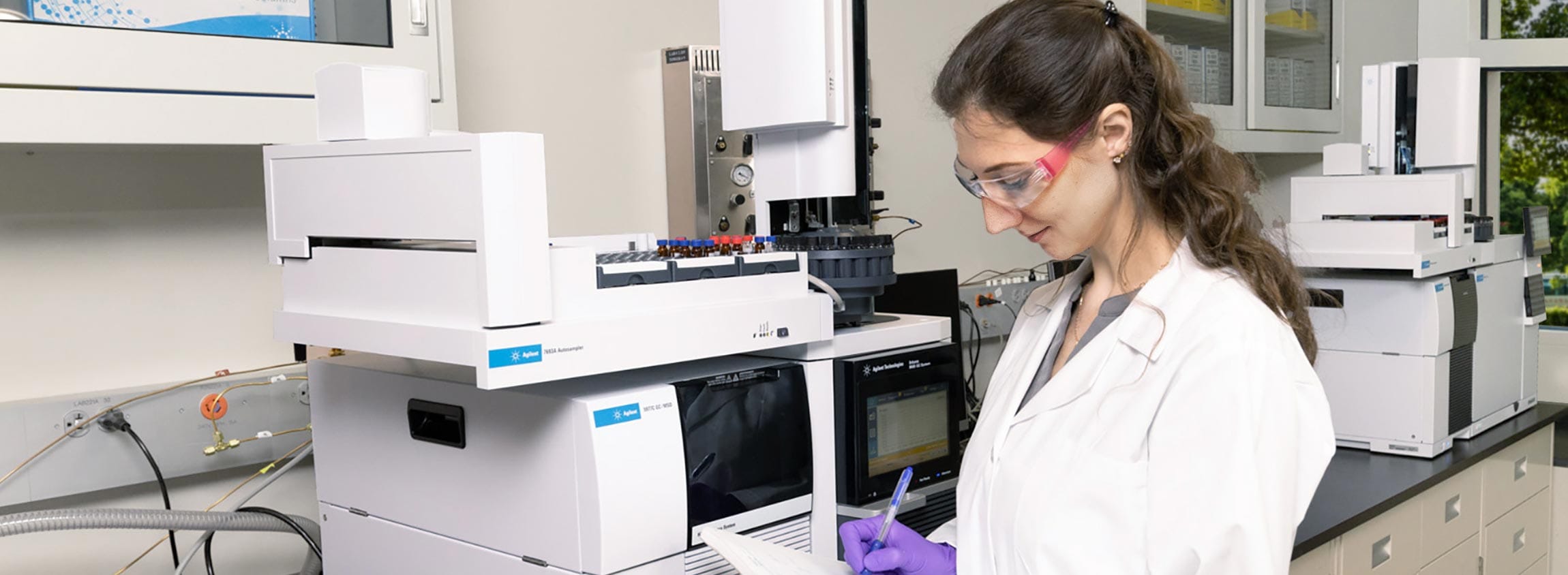Single quadrupole GC/MS
A reliable choice for routine applications, single quadrupole gas chromatography/mass spectrometry is a great alternative to traditional GC detectors. It is by far the most widely used GC/MS instrument type, with a diverse range of applications.
Read on for the fundamentals of SIM and Scan mode used in GC/MS.
The basic elements of a single quadrupole mass analyzer are an ion source, focusing lenses, a quadrupole, a detector, and a vacuum system.
Selective ion mode (SIM)
In SIM mode, the quadrupole mass filter is controlled to allow ions of specific m/z ratios to travel through the ion optics and into the detector. SIM enables high sensitivity for a selected number of analytes and is frequently used in quantitative analysis, as it offers the highest sensitivity.
Scan mode
In scan mode, the quadrupole is rapidly adjusted to sequentially pass a range of m/z values into the detector. Thanks to the development of stable high-speed electronics, the entire usable mass range of the GC/MS can be “scanned” in a fraction of a second. That means you can obtain full spectral information for multiple chromatographic data points across a peak.
Scan mode also lets you observe an almost unlimited number of analytes. Since the entire spectrum of ions is collected at each time point in the chromatogram, scan mode is ideal for compound identification through comparison to spectral libraries. It can also be used to help identify true unknown compounds.
Triple quadrupole GC/MS
Also known as tandem quadrupole gas chromatography/mass spectrometry, triple quadrupole GC/MS (GC/TQ or GC/QQQ) excels at sensitivity for targeted and trace-level analysis. The key to its high sensitivity is the ability to isolate an ion with one quadrupole (Q1), fragment it in the collision cell, then isolate one of the fragments in a tandem quadrupole (Q2). This technique is known as MS/MS, and it greatly reduces chemical noise while preserving ions of interest.
Most GC/TQs are used in the primary MS/MS mode known as Multiple Reaction Monitoring (MRM). However, they can also be used in other modes, depending on your qualitative goals. However, they can also be used in a variety of other modes including full scan, precursor and product ion scan, as well as mixed modes to help gather more information from your sample and support method development.
Quadrupole 1 selects a particular ion, which is passed into the collision cell. There, the selected ion smashes into neutral molecules and forms fragments, which are analyzed by the Q2 quadrupole.
MRM
MRM is an approach where you set the first quadrupole to filter an ion of interest (precursor ion) generated by your ion source. After the ion is transmitted through the first quadrupole (much like a SIM experiment), it enters a collision cell. There, energy is applied and collisions with gas molecules occur—a process known as collision induced dissociation (CID). These collisions reproducibly create more ion fragments, known as product ions.
The second quadrupole is used to isolate a product ion to create an MRM transition that is highly selective for the target analyte. Usually, the most abundant MRM transition is measured across a chromatogram for quantitation, and is referred to as a quantifier or target transition. You can build extra certainty into this method by adding more MRM transitions (known as qualifier transitions) specific to the analyte. It is common to have one to three qualifiers in addition to the quantifier transition.
Developing MRM methods can be more involved than SIM or scan methods, but software tools like MassHunter Optimizer help automate this process on Agilent GC/TQ instruments.
Time-of-flight high resolution mass spectrometry (HRMS)
High mass accuracy differentiates gas chromatography/quadrupole time-of-flight mass spectrometry (GC/Q-TOF) from unit mass spectrometry measurements on GC/MS and GC/TQ instruments.
Ideally, the mass of an atom or molecular mass of a compound is not a unit mass as is sometimes shown on data files. For example, oxygen has an exact mass of 15.9994 amu, not 16 amu. The error of measured mass versus theoretical mass with HRAM is usually between one and five parts-per-million (ppm). GC/Q-TOF resolution is high enough to allow for accurate mass detection of compounds to four or more decimal points.
GC/Q-TOF instruments combine the benefits of high selectivity and high sensitivity, producing precise results for samples in complex matrices. Much like high-resolution video, high resolution accurate mass spectrometry (HRAM) captures more precise mass spectrum details that might blur together on lower-resolution GC/MS and GC/TQ systems.
What happens inside a time-of-flight (TOF) analyzer?
- Ions are pulsed up the flight tube at very high rates (microsecond scale).
- As the ions travel up the tube, they separate with the largest ions moving more slowly. Arrival times can then be measured with extreme precision (nanosecond scale).
- Packets of ions (transients) are summed together to create a spectrum. It typically takes data from approximately 10,000 transients to create a full spectrum.
Full scan mode
Full scan mode—also known as Total Transmission of Ions (TTI) or Total Ion Chromatography (TIC)—is the most common mode. GC/Q-TOF can also be used in semitargeted or fully targeted modes, improving selectivity by harnessing the quadrupole and collision cell to perform MS/MS experiments.
Because of their strong selectivity and identification/structural elucidation capabilities, GC/Q-TOF systems are often used to identify unknowns. They also provide highly reliable measurements in routine quantitative work.






